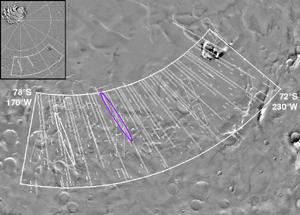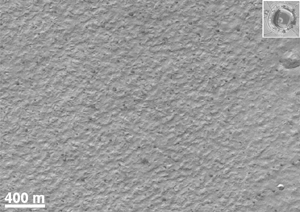
Mars Global Surveyor
Mars Orbiter Camera
Mars Global Surveyor Views of the Mars Polar Landing Site
MGS MOC Release No. MOC2-174, 25 August 1999
High-resolution views of the
Mars Polar Lander
landing zone were essential
to the selection of a safe place for the December 3, 1999, landing to occur.
The Mars Global Surveyor (MGS) Mars Orbiter Camera (MOC)
took its first pictures of the landing zone in
December 1997 and
January 1998.
After that time, the south
polar region was not accessible to the camera until June 1999, when the
south polar winter was ending and the sun began to dawn on this region
once again. Since the beginning of June 1999, an intense period of
imaging has been conducted over the landing zone so that a safe site could
be found. The final site has now been identified, and the pictures
shown here give some idea of what the Mars Polar Lander will encounter
a little more than three months from now.

MOC2-174a: MGS MOC Coverage of Mars Polar Lander Region
This figure shows the zone originally proposed by the
Mars Volatiles and Climate Surveyor (MVACS)
science team for the Mars Polar Lander
mission, which spanned the region from 72° to 78°S latitude
and 170° to 230°W longitude. The thin white boxes and lines crossing
the proposed zone outline MOC images taken between the first week in
June 1999 and the first week in August 1999. The longest images were taken
at 12 by 18 meters (39 by 59 feet) per pixel; there are three sets of long
images, each taken
during a given week in June as the terminator (the line separating "night"
from "day") moved south across the landing zone. Smaller swaths represent
images at higher resolution. The best resolution so far achieved is about
4 meters (13 ft) per pixel; better images will be taken in September and
October as the sun
rises farther and the surface becomes better illuminated. This figure shows
the location of the primary (blue) and secondary (white) landing ellipses,
which were selected on the basis of interpretation of the MGS data, in
particular data from the
Mars Orbiter Laser Altimeter and the
Mars Orbiter Camera.
The selection criteria were to find a place that was relatively flat
and relatively smooth, but which displayed characteristics of the south polar
layered materials. The inset (upper left) shows the location
of the landing zone with respect to the south polar residual (year-round)
ice cap. The base map used here is a mosaic of Viking Orbiter images
from the U.S. Geological Survey.
For the highest-resolution view of this figure (230 Kbytes),
Click HERE.

MOC2-174b: Mars Polar Lander and Mars Pathfinder Sites Compared
This figure shows a comparison at the same scale (about
5 meters--16 feet--per pixel) of the 1997 Mars Pathfinder landing
site (left) and a
representative portion within the primary landing ellipse
designated for the Mars Polar Lander (right). Familiar landmarks at the
Mars Pathfinder site include the "Twin Peaks" (center left), "North Peak"
(top), and "Big Crater" (lower right). The south polar layered deposits are
generally
devoid of the large craters and hills seen at the Pathfinder site. The
"wavey" texture at the Pathfinder site (the result of the movement of
sediment by the large flood that swept through that location billions of
years ago) is replaced at the proposed Mars Polar Lander site by a random
arrangement of very low ridges and grooves that suggest the surface has been
exposed to erosion by ablation of ices. When the picture on the right was
taken, the surface was still mostly covered by winter-time carbon dioxide
frost. However, as the sun rises higher, the carbon dioxide frost sublimes
(goes directly from solid to vapor), creating the dark spots that are just
barely visible in this image. Illumination is from the lower right in
both pictures.
For a higher resolution view of this figure (1 .2 Mbytes),
Click HERE.
For pictures showing the location of Mars Pathfinder,
Click HERE.

MOC2-174c: Mars Polar Lander Site Surface Details
This picture is an enlargement of a portion of a MOC image taken
in late July 1999, showing the onset of defrosting of the seasonal
carbon dioxide frost cap (small, occasionally fan-shaped dark spots
seen throughout this image). Two craters are seen in this image, a very
rare occurrence on the south polar layered deposits. Shown for comparison
at the same scale is a picture of Jack Murphy (now Qualcomm) Stadium in
San Diego, California. Clearly visible in the inset is the baseball diamond
and pitcher's mound; less clear but certainly visible are a
number of automobiles (small light dots) in the parking lot west
(to the left) of the stadium. The elevation of the sun in the Mars
image is about 10°; the sunlight is coming from the bottom (north)
in this image. The shadow of the rims of the craters can be used to
determine their depths. The smaller crater in the bottom right corner is
about 60 m (197 feet) across and 7 m (23 feet) deep; the large
crater just below the inset is 175 m (574 feet) across and 17 m (56 feet)
deep. Similar calculations for other features in the images indicate that
much of the surface is smooth and flat. Relief is typically much less than
1-2 meters (3-7 feet) in height over areas of 10-15 meters across
(33-49 feet).

MOC2-174d: Mars Polar Lander Site Compared With Washington, D.C.
This figure compares five representative views of the Mars Polar Lander
primary ellipse near 76°S, 195°W, with a similar-sized
view of the U.S. capital for scale. Each box is approximately
1.2 km (0.75 mi) on a side. The brightness variations from one box to
another among the Mars images reflects different amounts of frost cover,
and possibly the differing compositions of frost
(i.e., carbon dioxide vs. water ice).
The brightness also depends upon surface texture both above
and below the scale of these images (about 5.5 meters--18 feet--per pixel).
These pictures show the range
of surface texture and morphology that is found within the landing ellipse.
Mounds and valleys that range from a few meters to as much as
one hundred meters (328 ft) across--with relief of a few meters--dominate
the landing site. All of the frost seen here is expected to be gone
by the time the Mars Polar Lander arrives in December 1999.
The Mars images are illuminated from the lower right. The view of
Washington D.C. shows the Capitol Building at the center right and
the National Air and Space Museum at center left (immediately below
the grassy rectangles of the Mall).
Additional MOC Pictures of the Mars Polar Lander and Mars Pathfinder landing
regions:
-
"South Polar Layered Deposits near Proposed Mars Surveyor '98 Landing Site," MOC2-25, March 9, 1998
-
"Additional Images of South Polar Layered Deposits near Proposed Mars Surveyor '98 Landing Site," MOC2-26, March 9, 1998
-
"Pathfinder Landing Site Observed by Mars Orbiter Camera," MOC2-46, April 25, 1998
-
"Mars Pathfinder First Anniversary Special--Refined Landing Site Location in MOC Image 25603," MOC2-56, July 3, 1998
Mars Polar Lander and Mars Pathfinder Web Sites:
Malin Space Science Systems and the California Institute of Technology
built the MOC using spare hardware from the Mars Observer mission. MSSS
operates the camera from its facilities in San Diego, CA. The Jet Propulsion
Laboratory's Mars Surveyor Operations Project operates the Mars Global Surveyor
spacecraft with its industrial partner, Lockheed Martin Astronautics, from
facilities in Pasadena, CA and Denver, CO.
 To MSSS Home Page
To MSSS Home Page
Contact: info@msss.com





